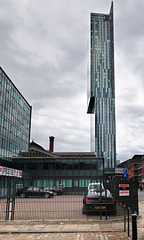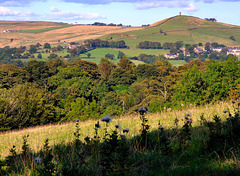Phil's photos with the keyword: Tower
Hilton / Beetham Tower (HFF).
| 25 Jul 2015 |
|
|
|
The Beetham Tower (A.K.A. The Hilton Tower as it contains the Hilton hotel) is a mixed-use skyscraper in Manchester, England. Completed in 2006, it is named after its developers, the Beetham Organisation and was designed by Ian Simpson. At a height of 551 feet (168 m) it is the tallest skyscraper in Manchester and the tallest building in the UK outside London. Upon opening in 2006 it was the tallest residential building in the United Kingdom and second-tallest in Europe. It is one of the thinnest skyscrapers in the world with a height to width ratio of 12:1 on the east-west facade.
en.wikipedia.org/wiki/Beetham_Tower,_Manchester
Camera: Nikon D300s
Lens: Nikkor 17-55mm f2.8
Processed with Nikon Capture NX2
Sky and steel.
| 05 Oct 2014 |
|
|
|
Pendle Forest TV & radio relay mast, situated on the ridge between the villages of Fence and Spen Brook in Lancashire, North-West England. This is a part of the Winter Hill (near Bolton, about 15 miles South of here) group of transmitters and acts as a relay for the towns and villages around the Pendle area.
Photographed with a Sony RX100 camera and processed with Nikon Capture NX2 software.
York Minster's twin towers.
| 20 Jul 2014 |
|
|
|
The North and South towers of York Minster (see NOTES). There is also a higher central tower (out of shot to the left) with a viewing area which is open to the public. Photographed with a Panasonic TZ10 camera and processed with Nikon Capture NX2.
York Minster is a cathedral in York, England and is one of the largest of its kind in Northern Europe. The minster is the seat of the Archbishop of York, the second-highest office of the Church of England and is the cathedral for the Diocese of York. The title "minster" is attributed to churches established in the Anglo-Saxon period as missionary teaching churches and serves now as an honorific title.
The minster has a very wide Decorated Gothic nave and chapter house, a Perpendicular Gothic Quire and East end and Early English North and South transepts. The nave contains the West Window, constructed in 1338 and over the Lady Chapel in the East end is the Great East Window (finished in 1408), the largest expanse of medieval stained glass in the world. In the North transept is the Five Sisters Window, each lancet being over 52 feet (16 m) high. The South transept contains the famous rose window, while the West Window contains a heart-shaped design colloquially known as 'The Heart of Yorkshire'.
(Wikipedia).
York castle ("Clifford's Tower").
| 04 Oct 2013 |
|
|
|
York Castle in the city of York, England, is a fortified complex comprising, over the last nine centuries, a sequence of castles, prisons, law courts and other buildings on the south side of the River Foss. The now-ruinous keep of the medieval Norman castle is commonly referred to as Clifford's Tower. Built originally on the orders of William I to dominate the former Viking city of York, the castle suffered a tumultuous early history before developing into a major fortification with extensive water defences. After a major explosion in 1684 rendered the remaining military defences uninhabitable, York Castle continued to be used as a jail and prison until 1929.
The first motte and bailey castle on the site was built in 1068 following the Norman conquest of York. After the destruction of the castle by rebels and a Viking army in 1069, York Castle was rebuilt and reinforced with extensive water defences, including a moat and an artificial lake. York Castle formed an important royal fortification in the north of England.
In 1190, 150 local Jews were killed in a pogrom in the castle keep. Henry III rebuilt the castle in stone in the middle of the 13th century, creating a keep with a unique quatrefoil design, supported by an outer bailey wall and a substantial gatehouse. During the Scottish wars between 1298 and 1338, York Castle was frequently used as the centre of royal administration across England, as well as an important military base of operations.
York Castle fell into disrepair by the 15th and 16th centuries, becoming used increasingly as a jail for both local felons and political prisoners. By the time of Elizabeth I the castle was estimated to have lost all of its military value but was maintained as a centre of royal authority in York. The outbreak of the English Civil War in 1642 saw York Castle being repaired and refortified, playing a part in the Royalist defence of York in 1644 against Parliamentary forces. York Castle continued to be garrisoned until 1684, when an explosion destroyed the interior of Clifford's Tower. The castle bailey was redeveloped in a neoclassical style in the 18th century as a centre for county administration in Yorkshire and was used as a jail and debtors' prison. Prison reform in the 19th century led to the creation of a new prison built in a Tudor Gothic style on the castle site in 1825; used first as a county and then as a military prison, this facility was demolished in 1935. By the 20th century the ruin of Clifford's Tower had become a well-known tourist destination and national monument; today the site is owned by English Heritage and open to the public. The other remaining buildings serve as the York Castle Museum and the Crown Court.
(Wikipedia).
Blacko: the village and tower.
| 08 Jun 2013 |
|
|
|
Overlooking the village is Stansfield Tower (a.k.a. Blacko Tower), which was built around 1890. A local grocer, Jonathan Stansfield, built this circular rough stone tower to provide himself with a view over Ribblesdale from the top but the height fell somewhat short. A Bronze Age axe believed to be 3,500 years old was found near the tower in 1952.
(Wikipedia)
www.ipernity.com/group/england
York castle (Clifford's tower).
| 03 Jun 2013 |
|
|
|
The now-ruinous keep of the medieval Norman castle is commonly referred to as Clifford's Tower. Built originally on the orders of William I to dominate the former Viking city of York, the castle suffered a tumultuous early history before developing into a major fortification with extensive water defences. After a major explosion in 1684 rendered the remaining military defences uninhabitable, York Castle continued to be used as a prison until 1929.
(Wikipedia).
www.ipernity.com/group/england
www.ipernity.com/group/history</a
Jump to top
RSS feed- Phil's latest photos with "Tower" - Photos
- ipernity © 2007-2025
- Help & Contact
|
Club news
|
About ipernity
|
History |
ipernity Club & Prices |
Guide of good conduct
Donate | Group guidelines | Privacy policy | Terms of use | Statutes | In memoria -
Facebook
Twitter






